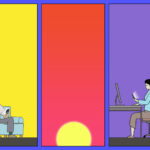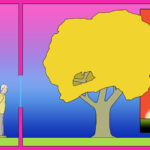Cognitive distortions are patterns of thinking that are not supported by facts. These patterns of problematic thinking often occur unconsciously, forming habitual ways of interpreting the world, others, and oneself. They often arise in childhood when the ability to fully question or reason through one’s own interpretations and those of others is still developing.
Many cognitive distortions are legacy beliefs and rules passed forward through generations or are understandable individual adaptations born of hardship. Some cognitive distortions can be part of long-held, collective and powerful belief systems held by one’s family, community, society, or religion.
Accompanied by self-kindness and self-compassion, a person can begin to recognize the complexity of reality, to gently become aware of cognitive distortions, and to free themselves from limits and confinements in their thinking. This awareness lets a person see the facts and reality as they are and create reality-based strategies for addressing life’s moments, decisions, and challenges.
Reality is complex.
Here are some examples of cognitive distortions:
- just-world hypothesis – belief that good things happen to good people, bad things happen to bad people, hard work will be rewarded, bad deeds will be punished, and things happen for reasons; belief that self, others, and the world should be controllable, orderly, predictable, fair, and just. Here is more about freeing oneself from the just-world hypothesis.
- insistence – belief that life – and the people and institutions in it – should provide what we want and need, including love, happiness, and opportunities, that we deserve it, are entitled to it, and/or have a right to it, and, if it’s not provided, people and life are purposely and unfairly withholding it from us or something is wrong with us, them, or the way the world works; this thinking is related to the just-world hypothesis and “should-statements” and rules
- hindsight bias – perceiving past events as having been more predictable than they actually were; holding an”If _____, then _____” belief. Reality is complex and the human brain cannot see the future. Things might have been better, worse, or no different.
- trauma narrative – belief that one’s selfhood/personhood is irreparably damaged and broken by trauma and hardship*
- external locus of control – believing others’ needs and wants determine one’s actions vs. internal locus of control where one’s values and priorities determine one’s choice of actions; assigning unmerited direction, causality, and responsibility to factors outside of oneself
- dichotomous thinking – believing things are absolutely all-or-nothing, black-or-white, right-or-wrong, good-or-bad, either-or; siphoning off selected data from which to draw conclusions vs. attempting to view the entirety of reality and draw conclusions from a broad, realistic view
- one way – a direction-seeking form of dichotomous thinking born of attempting to answer the existential question, “What is to be done?”: “There is one way. There is one way to do things. If you’re not doing things that way, then how you’re doing them is wrong. There’s one way to be. If you’re not that way, then who you are and how you are in the world are wrong.”
- negativity bias – discounting the positive and highlighting the negative; mentally filtering out the positive; may include “positivity bias” towards other people and other life circumstances as part of an external locus of control
- maximizing/magnification – seeing the negative results of actions or situations as larger or more meaningful than they really are
- minimizing – seeing the results of actions or situations as smaller than they really are; can include “toxic positivity,” an unrealistic, unempathetic, invalidating, unhelpfully cheerful attitude; exemplified by “Look on the bright side” and “It could be worse.”
- fortune-telling – catastrophizing; imagining the worst possible outcomes and the worst case scenario; also termed “awfulizing” by Albert Ellis
- unfair comparisons – using unrealistic standards; comparing one unrelated thing to another in order to make something look more or less valuable than it really is; examples: “Why can’t you be more like ______?” and “Other people have it worse than I do.”
- emotional reasoning – believing that if you feel it, it must be true, even when there’s no supporting evidence
- labeling – using a single behavior, trait, or characteristic to describe and judge a whole person
- overgeneralization – applying one experience to all experiences; from one example, drawing conclusions about all instances; believing if one person does something, all “those” people do it; believing if another person has even one trait like you do, you are soulmates, one and the same
- selective abstraction – forming conclusions based on an isolated detail of an event and ignoring the context or other relevant details
- jumping to conclusions – judging or deciding without all the facts
- mind reading – assuming you know what other people are feeling and thinking and can narrate their stories for them
- personalization – believing situations, conditions, or others’ actions are solely in response to you
- “should-statements” and rules – includes “shoulds, “musts” and “have-tos” applied to situations, regardless of the complexity of the circumstances vs. making conscious choices based on one’s best assessment of the situation at the time
- wishful thinking, magical thinking, daydreaming, fantasizing – when not used for creative purposes, believing fervently that wishing it so can make it so
- opposition or defensiveness – when used to offer a sense of control and power rather than to gain understanding, insight, or connection
- avoidance and distraction – to avoid and evade acknowledgement of painful realities rather than adapt to them
- self-blame, other-blame, and/or institution-blaming even when facts show responsibility for what happened is complex
This Checklist of Cognitive Distortions by David Burns, Ph.D. may also be of assistance.
In Cognitive Processing Therapy, a “Stuck Point” is a term used to describe a cognitive distortion. From Cognitive Processing Therapy for PTSD: A Comprehensive Manual by Patricia A. Resick, Candice M. Monson, and Kathleen M. Chard, Guillford Press, 2016, page 95: “A Stuck Point is a thought that you probably formed during or shortly after the trauma about why the trauma happened or what it means about yourself, others, and the world. It serves to keep you stuck in place and stops your recovery and growth.”
*Of possible interest: Parul Sehgal, The Case Against the Trauma Plot, The New Yorker, 12/27/21
Last updated 9/16/2024
This content is for informational purposes only and is not a substitute for medical or professional advice. Consult a qualified health care professional for personalized medical and professional advice.


